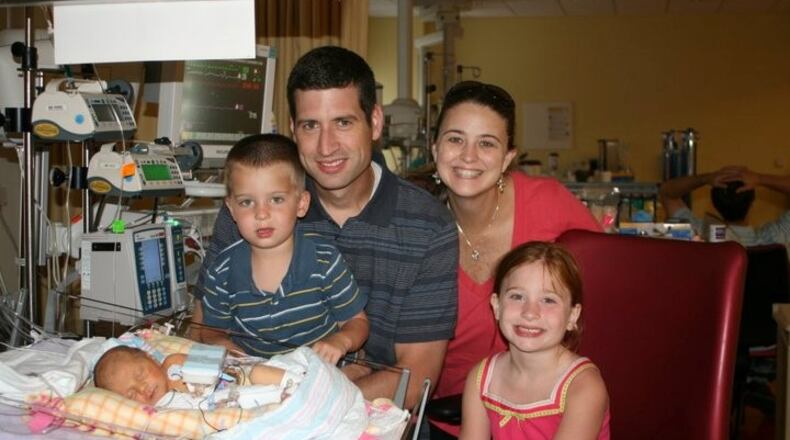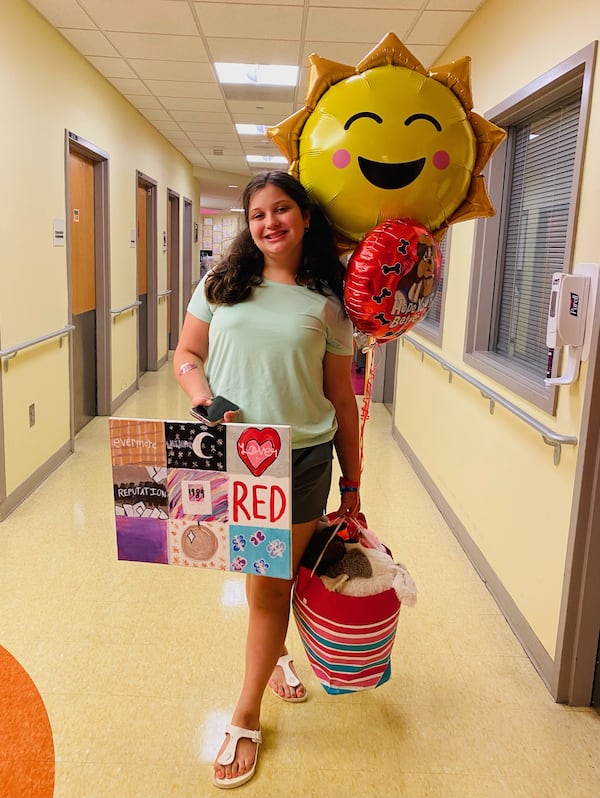For most teenagers, just surviving puberty and keeping up with studies, after-school activities and a social life is enough of a challenge. Audrey Koch, 14, has much bigger concerns. She’s had more potentially fatal heart emergencies than years of life. The Roswell teen never knows when she might faint, causing the latest defibrillator implanted in her chest to charge her heart back to life if it misses a beat.
Audrey is one of about 200 kids Children’s Healthcare of Atlanta treats each year for Long QT syndrome. The heart condition affects about 1 in 2,000 people in the United States. Although it’s typically inherited, Audrey is the first in her family with the abnormal heartbeat complication. Her case brings awareness to American Heart Month in February.
“I usually feel light-headed, and it happens really quickly before I pass out,” said Audrey, an eighth grader at High Meadows School. “My heart gets out of rhythm. The device implanted in me shocks my heart. I don’t feel it. I wake up a little sore.”
Credit: Amanda Koch
Credit: Amanda Koch
Audrey has an aggressive form of the condition named after a section of an electrocardiogram (ECG), which records electrical signals as they move through the heart. The QT interval represents the time it takes for the heart muscle to contract and recover. With Long QT syndrome, the heart’s electrical system takes longer than normal to recharge between heartbeats, according to the Cleveland Clinic.
Half of those with Long QT syndrome never have symptoms. Up to 21% of untreated people with symptoms die within a year after they start fainting, the Cleveland Clinic reports. But if diagnosed and treated, the death rate is about 1%.
Young people with the condition have a higher risk of sudden cardiac death, according to the Mayo Clinic.
Audrey’s condition was discovered when her mother, Amanda, was 25 weeks pregnant. During a routine pregnancy checkup, doctors detected the baby’s abnormal heart rhythm.
Northside Hospital’s high-risk pregnancy team, with the help of Children’s pediatric cardiologists, attempted to control the irregular heartbeat by giving Amanda medicine, but determined they could better treat the baby after birth.
Audrey was born early and officially diagnosed at that time with Long QT syndrome. At 4 days old, she had a pacemaker surgically implanted to prevent cardiac arrest, said her doctor, Peter Fischbach, a pediatric cardiologist at Children’s.
Credit: Children's Healthcare of Atlanta
Credit: Children's Healthcare of Atlanta
She’s had multiple surgeries since then and five implantable defibrillators, which periodically have to be updated with new batteries and wires, Fischbach said.
The pacemaker sends electric signals to the heart to keep it beating in a regular rhythm and when the heartbeat is too fast or chaotic, the defibrillator shocks the heart to stop the abnormal rhythm.
She will have to deal with the condition her entire life, Fischbach said. “It’s one of the diseases that is never going away. You don’t outgrow it.”
Meanwhile, treatment improvements, genetic therapy and research into the condition continue to evolve, albeit slowly, he said.
“It’s a newly recognized disease. … We’ve only known about it for the last 50 years.”
At this point, the only defibrillators on the market are made for adults and have to be retrofitted to squeeze into a child, Fischbach said.
People who had the condition previously were discouraged from participating in competitive sports. But many were athletic and the activity didn’t cause heart issues, he said.
A study last year published in the American Heart Association’s Circulation journal showed that risk for cardiac complications was low for patients with the most common forms of Long QT whether they vigorously exercised or were less active. The multinational study funded by the National Institutes of Health followed more than 1,400 patients ages 8 to 60 for more than three years.
The results are paving the way for new cardiology guidelines about exercising with the condition, said Rachel Lampert, a sports cardiologist and electrophysiologist at Yale School of Medicine who led the study and researches similar issues. She cited examples of targeted treatments and surgeries along with advances in gene therapy on the horizon. “The fact that exercise is safer than we thought also is very exciting.”
Fischbach agrees. “In my career, I’ve seen a change in how we manage kids with the condition. We have become a lot more permissive.”
He recalls how genetic testing has advanced from three labs in the world that could test for the condition. “We would draw blood … send a sample and with luck in one to two years we’d get a result back.” Now it takes four weeks to receive test results, he said.
Once genetic counselors determine a family member has the condition, parents and other relatives are tested. In 80% of the cases in which patients exhibit signs of Long QT syndrome, genetic testing confirms the condition, Fischbach said.
In Audrey’s case, gene testing determined neither of her parents or older siblings had the disorder. So Audrey is the only carrier and if she has children, they have a 50% chance of having the abnormal gene, he said.
Credit: Amanda Koch
Credit: Amanda Koch
Audrey said she doesn’t dwell on her condition and limitations. She focuses on what she enjoys: listening to music, baking, volunteering with the mother-daughter National Charity League and attending Camp Braveheart, part of Children’s camp for children with cardiac disorders at Camp Twin Lakes in Rutledge, Georgia.
Her family is deciding whether she should attend a school class trip that will involve hiking at high altitudes, which could raise her adrenaline level and strain her heart. She still participates in physical education in school and could join a sports team if she wanted. “The specific type of Long QT syndrome she has is not necessarily triggered by athletic activity,” Amanda said.
So far, she’s been “amazingly lucky” that none of her 15 heart-related emergencies occurred while she was at school, Amanda said. Family has been around at those times, but they have prepared friends and teachers how to respond to similar incidents.
Amanda admits when her daughter faints “it’s a scary event.” A remote-control device held close to Audrey’s shoulder can read the implantable defibrillator so doctors can determine how the heart is beating, if the family should call paramedics or come to the hospital. The family also has an external defibrillator for emergencies.
“My husband and I are really quick to gauge the seriousness of the condition and what it could lead to. We have to be prepared and not let our guard down.”
Still, Amanda is confident Audrey will become self-sufficient. “We fully expect Audrey to be able to do anything she wants in life.”
Fischbach believes that Audrey handles the condition with remarkable maturity.
“Just having this disease is a tremendous psychological burden, knowing you can die at any moment,” Fischbach said. The stress the family has to endure is “unimaginable,” he added. “That they’ve done it with grace is awe-inspiring.”
Audrey said she tries to keep calm. “I know I have people around me if something were to happen. They know what to do. That makes me feel more comfortable.” Her advice to those with Long QT syndrome: “Make a point of meeting other kids [with the condition]. Keep positive. Keep doing what you love. The more you like something, it will distract you from everything else medically going on.”
Roni Robbins has been a journalist for 37 years. This is her second stint as a freelance reporter for the AJC. She also freelances for Medscape, where she was an editor. Her writing has appeared in WebMD, HuffPost, Forbes, NY Daily News, BioPharma Dive, MNN, Adweek, Healthline, and others. She’s also the author of the award-winning Hands of Gold: One Man’s Quest to Find the Silver Lining in Misfortune.
About the Author
Keep Reading
The Latest
Featured





